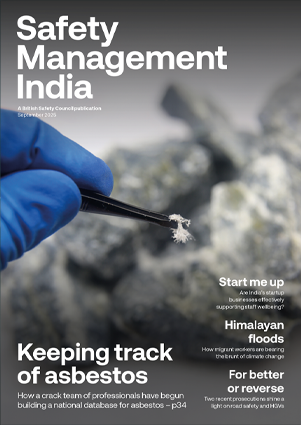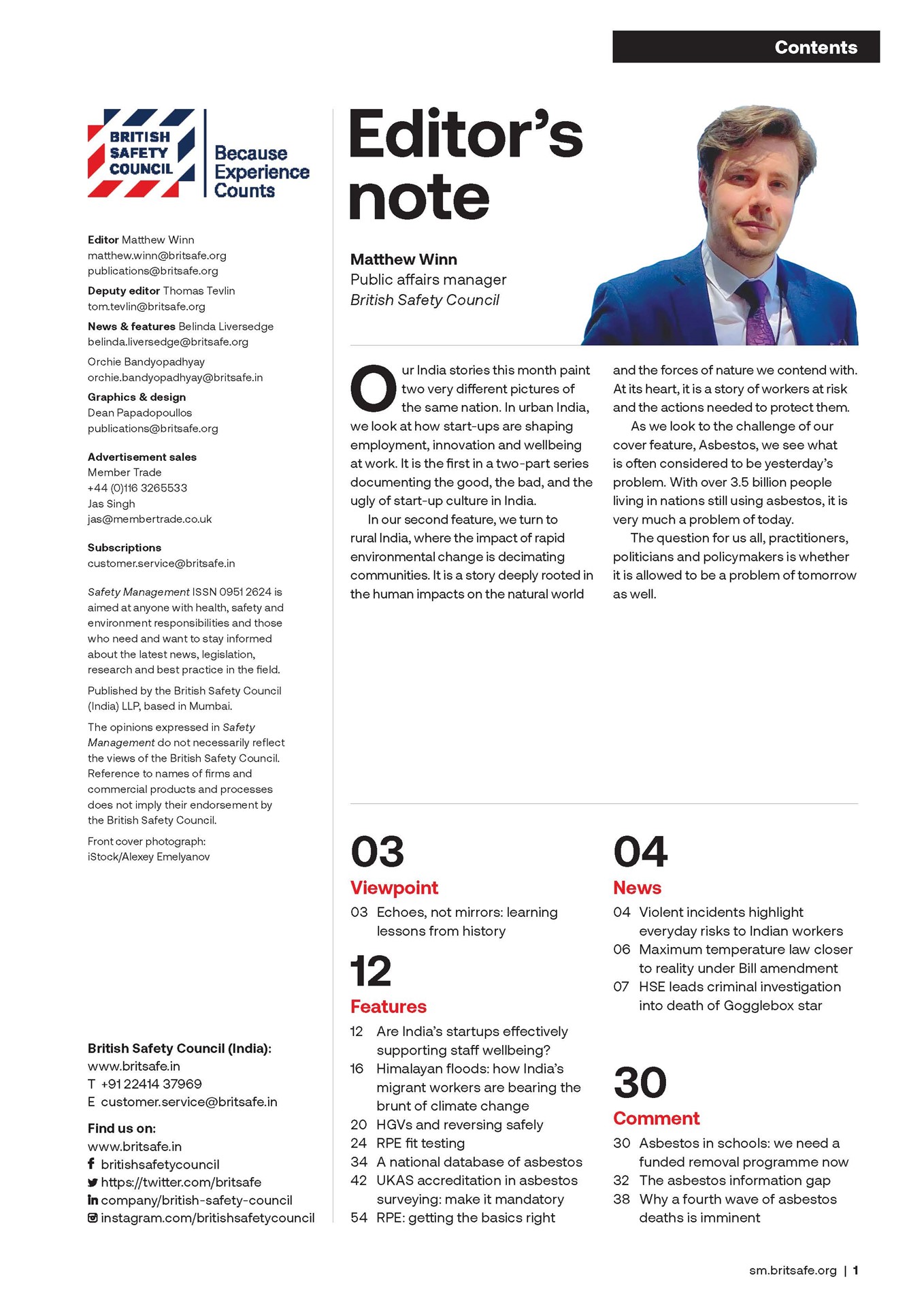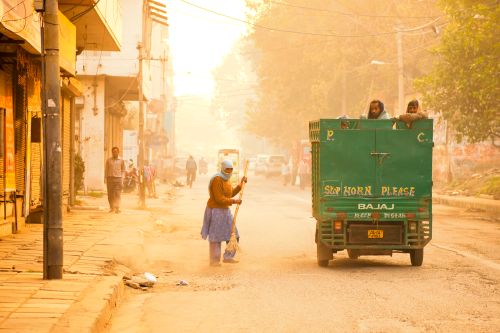Although India banned bonded labour almost 50 years ago, the practice still persists throughout the country, prompting calls for the union and state governments to drastically step up their efforts to eradicate it.
Features
Bonded labour: a persistent problem in India
Although the practice of bonded labour or forced work was abolished in India in 1976, every year hundreds of fresh cases come to the attention of local authorities, anti-slavery campaigners and the media. This year, too, was no different.
In May, a duck farmer in the Tirupati district of Andhra Pradesh was arrested along with his wife and son for allegedly holding a nine-year-old boy from a nearby tribe in bonded labour until his mother cleared a Rs 25,000 debt she allegedly owed the farmer. The farmer’s family have been accused of burying the boy’s body after he reportedly died due to jaundice while living and working on their farm, according to police officials.

According to media reports, the boy’s mother, Anakamma, contacted the accused, Muthu, offering to return his money so she could take her son home. However, after receiving evasive and vague responses from Muthu about the boy’s whereabouts, Anakamma contacted Tirupati police, who launched an investigation. The local police subsequently discovered that the boy, Venkatesh, had passed away and his body had been buried without his family being informed of either his death or the burial.
In her complaint, Anakamma said that she and her husband, Chenchaiah, had worked for Muthu in the Satyavedu area of Tirupati until Chenchaiah passed away in 2024. Following her husband’s death, Anakamma borrowed Rs 25,000 from Muthu.
Anakamma alleges that when she subsequently attempted to leave the duck farm, Muthu demanded Rs 42,000, claiming she owed this to cover the original loan of Rs 25,000 together with accrued interest.
“She promised to repay the money within 10 days, and Muthu agreed but insisted on having the boy as collateral, who would continue to work,” stated a police officer involved in the investigation, according to media reports. “She left her son behind and communicated with him through the employer’s phone. The last conversation she had with him was on 15 April.”
In April, after Anakamma was able to pull together the funds required to free her son, she contacted Muthu, informing him that she was coming to take Anakamma and would pay the required sum. However, Muthu said the boy had left and travelled to Kanchipuram in Tamil Nadu, although he later stated Anakamma had become was sick and been hospitalised. Following questioning by Anakamma, he changed his story again and said the boy had fled, according to a statement released by the police, based on Anakamma’s official complaint.
However, after Anakamma contacted the superintendent of police in Tirupati urging the local force to investigate further, the authorities discovered that Venkatesh had in fact died and been secretly buried in Kanchipuram.
Labourers rescued
Meanwhile, in another case that hit the headlines in February, 26 bonded labourers, along with 22 of their family members, were rescued from a charcoal production unit in Pun, Maharashtra.
According to media reports, a man in control of the charcoal unit, named as Sayaji Bandalkar, allegedly forced a group of men to gather wood from the forest for the charcoal production process, and women and children were also held captive at the site and frequently forced to work on farms.
Shramajeevi Sanghathana, a not-for-profit campaign and advocacy group that works to support and secure the rights and livelihoods of Scheduled Castes and Scheduled Tribes in Maharashtra, collaborated with the authorities to help rescue the bonded labourers and their families.
Bandalkar has since been charged with offences under the Bharatiya Nyaya Sanhita criminal code and the Bonded Labour System (Abolition) Act 1975, and the Tehsildar for the Indapur region of Pune (a government official responsible for various administrative duties in the respective local area), has provided documentation to the labourers, officially releasing them from their bonded status, according to a statement from a local government official.
Definition of bonded labour
Essentially, bonded labour is a practice where employers grant high-interest loans to workers who in return are required to stay and work to pay off the debt. Frequently, the terms and conditions of the repayments are not formally agreed or clearly stated, meaning the workers have no certainty about when the debt will be paid and when they will therefore be allowed to leave the employer’s control.
In addition, bonded workers are often paid very low wages, which further forces them to remain under the employer’s control for long periods as they struggle to repay the loans and interest, sometimes trapping them in debt bondage for years.
The practice has traditionally been associated with the agricultural sector, although in recent years numerous cases have been discovered and reported in other areas of the unorganised rural and urban economy, such as brick manufacturing, stone quarrying, coal mining and domestic help.
Anti-slavery and anti-poverty campaigners say people from marginalised groups, such as Scheduled Castes and Scheduled Tribes, and the rural poor, are particularly vulnerable to becoming victims of bonded labour, as they are driven through poverty to seek low-paid and low-skilled work, and require funds to provide for their families, who often live in impoverished circumstances in deprived and remote rural areas.
Although India has committed to end all forms of forced labour, human trafficking and child labour in the country by 2030 in line with the United Nations Sustainable Development Goal (SDG) Target 8.7, campaigners say the practice continues to occur, trapping significant numbers of people in unending cycles of debt and despair.
In fact, union government statistics show that around 315,302 people were released from bonded labour between 1978 and January 2023, of which the Government claims 94 per cent were rehabilitated – for example, by giving them financial support.
According to a recent report in the Deccan Herald, almost 250 people were freed from bonded labour across India between April 2024 and January 2025, prompting a “distressed” Parliamentary panel to warn the figures are a stark illustration that the “scourge” persists in society and is “spreading its tentacles”.
Comprehensive strategy
The Parliamentary Standing Committee on Labour, Textiles and Skill Development, chaired by senior BJP MP Basavaraj Bommai, subsequently called on the union government to develop a comprehensive strategy to prevent future cases – and tackle current instances – of bonded and forced labour.
In particular, the Committee urged the union and state governments to pursue stricter penalties and punishment – and speed up prosecutions for employers who force people into bonded labour.
The Committee also called on the various governments to improve awareness among workers about the dangers of falling victim to bonded labour, and to provide improved rehabilitation services for freed workers – such as secure rehabilitation homes and centres, emotional support services, immediate medical assistance and free legal aid. The Committee also recommended that governments should do more to ensure that children rescued alongside their parents have suitable access to formal education.
According to government statistics, since 1978, officials have “rescued and rehabilitated” 297,038 bonded labourers, disbursing a total of Rs 106.25 crore to them.
In the approximate one-year period from 1 January 2024 until 31 January 2025, 246 bonded labourers were rescued and rehabilitated, compared to 673 in 2022–23 and 468 in 2023–24.
In 2016, the central government set a target to identify, free and rehabilitate 18.4 million people from bonded labour by the year 2030. To meet this target, the government needs to rehabilitate around 1.3 bonded labourers each year.
However, according to a report by Outlook India magazine in August 2024, which quotes an RTI (Right to Information) request made to the government, the rehabilitation rate for bonded labourers has decreased by about 80 per cent over the past three years, with an annual average of only 900 labourers being rehabilitated. The supporting data also shows that only 468 workers were rehabilitated in the 2023–24 period.
Also, a report by the IndiaSpend news website in 2023 found that if the government were to maintain its current rate of progress, just two per cent of the goal will be achieved by the year 2030.
Abolition of bonded labour
The Bonded Labour System (Abolition) Act 1976 was designed to ensure the abolition of all instances of bonded labour in India. Under the Act, responsibility for identifying people who have fallen victim to bonded labour and taking steps to release and rehabilitate them rests with state governments and local district administrations. The central government established a Central Sector Scheme for Rehabilitation of Bonded Labourers in 2016, with the aim of improving the implementation of the Abolition Act.
Under the scheme, a range of financial and non-financial support should be offered to people who have been identified as bonded labourers and released from their employer, to ensure they do not fall victim to bonded labour in the future. The financial and non-financial support should be provided once the individual has been issued with a bonded labour release certificate by a district magistrate or sub-divisional magistrate.
The support includes immediate financial assistance in the form of a cash payment, plus further payments designed to aid the individual’s rehabilitation, based on factors such as the level of exploitation suffered and the individual’s age and gender. The additional financial support for rehabilitation ranges between Rs 1 lakh and Rs 3 lakh – depending on the individual’s circumstances – although the aid is released only after the individual’s status as a bonded labourer is confirmed via the issuing of a bonded labour release certificate by a magistrate.
The scheme also provides various types of non-financial rehabilitation and support, such as being granted a site to build a house, being granted a low-cost dwelling unit, access to paid employment and support to raise animals – for example, to provide milk and foodstuffs for the household.
However, labour exploitation activists and experts argue that identifying people subject to bonded labour is not a priority for state governments, and district authorities often fail to provide release certificates, which are mandatory for workers to access the available rehabilitation entitlements.
Campaigners say this reflects the failure of central and state governments (and state authorities), to adopt and implement a systematic and long-term approach to ensure the abolition of bonded labour. Activists argue state governments and district administrations should have a comprehensive and well-funded and well-staffed system to identify bonded labourers and take all necessary steps to ensure those freed are not enslaved once more. “But, first and foremost, authorities have to accept the severity of the problem,” warns one activist.
11 million people in modern slavery
According to the Global Slavery Index produced by Walk Free Foundation, an international human rights organisation dedicated to eliminating modern slavery, in 2021, around 11 million people in India were subject to modern slavery. This includes forced labour, debt bondage, forced marriage, other slavery and slavery-like practices (such as forced commercial sexual exploitation of adults and children), and human trafficking. In fact, Walk Free says India has the highest estimated total number of people living in modern slavery globally, and the sixth highest prevalence in the Asia Pacific region.
The Global Slavery Index also shows that India is ranked the 34th highest out of 160 countries globally for the prevalence of modern slavery, with an estimated eight people in modern slavery for every 1,000. The population’s vulnerability to modern slavery is ranked a poor 56 out of 100, although Walk Free says the Indian’s government response rating to modern slavery (46 per cent) is above the regional average.
Meanwhile, in a recent report on bonded labour in South Asia, Anti-Slavery International points out that after the Bonded Labour System (Abolition) Act was implemented, thousands of bonded labourers were identified, freed and rehabilitated as a result of state and judicial action in the late 1970s and early 1980s. However, the pace of identification and release slowed down during the 1990s, because officials were underestimating the extent of bonded labour and were oblivious to emerging forms, argues Anti-Slavery International. According to the report, in recent years, progress in identifying, freeing and supporting victims of bonded labour has primarily come from grassroots and civil society groups rather than governmental action.
Barriers to rehabilitation
Campaigners argue that, even after being released, many former bonded labourers face barriers to rehabilitation due to corruption, mismanagement and local political influences that favour the interests of local elites and employers.
For instance, although people freed from bonded labour are meant to be able to access various government-funded support services, activists say the training and compensation provided in these rehabilitation programmes is often insufficient to address the needs of the released individuals.
In addition, there have been instances where state governments have failed to address the bonded status of individuals who are part of a wider family unit that has been subject to bonded labour.
For example, there have been reports of magistrates refusing to issue bonded labour release certificates to women – preventing them from accessing financial and non-financial support for their rehabilitation and state benefits – because the labourer-employer contract was established solely with the head of the family, typically the husband. Therefore, campaigners say that while there have been interventions by states to free, support and rehabilitate bonded labourers, the state government efforts have not been consistent or comprehensive.
Vijaya Bharathi Sayani, acting chair of the National Human Rights Commission (NHRC) of India – which is responsible for protecting and promoting human rights in the country – says that, despite ongoing efforts by state governments, district authorities and independent support groups like workers’ rights campaigners, significant numbers of people continue to fall victim to forced labour and debt bondage.
“While the NHRC has implemented important initiatives, such as issuing advisories aimed at identifying, releasing and rehabilitating bonded labourers, the persistence of bonded labour across different industries suggests that significantly more action is required,” said Bharathi Sayani. “Bonded labour is referred to by various names, extending into non-agricultural sectors, including the Devadasi system and small-scale industries.”
Stronger measures
Bharat Lal, secretary general and CEO of the NHRC, argues that stronger and more effective measures must be taken to end the scourge of bonded labour.
The former high-ranking government civil servant says that India has a societal value system that provides the ethical impetus for the country to deal with the problem. Therefore, as well as the union and state governments taking appropriate action to enforce the ban on bonded labour – and effectively rolling out rehabilitation schemes and financial support for freed labourers – the government must build societal awareness about the need to prevent people falling victim to bonded labour.
Meanwhile, in a separate recent development, the government of Karnataka – which is led by the Indian National Congress party politician Siddaramaiah and viewed as one of India’s most progressive states – has appointed 52 ‘Bonded Labour Prohibition Officers’ to crack down on the practice, which reportedly that still occurs in Bengaluru and 10 other districts of the state. These officials are responsible for preventing instances of bonded labour, collecting evidence to ensure the successful prosecution of employers and contractors who force people into bonded labour, and improving awareness among citizens and businesses about the dangers of people falling victim to bonded labour and the consequences for employers who break the law in this area.
According to official statistics, between 2016 and 2024, Karnataka recorded 2,631 cases of bonded labour. Also, during the same period, the state provided pensions to 4,397 individuals who had been ‘freed’ from bonded labour. The Karnataka state government also offers a monthly payment of Rs 2,000, an increase from the previous level of Rs 1,000, to individuals who have been rescued from bonded labour.
The districts of Karnataka with the highest incidence of bonded labour cases include Bengaluru Urban, Chikkaballapur, Hassan, Mandya, Mysuru, Chikmagalur, Belagavi, Bagalkot, Ramanagara, Kolar and Tumakuru, according to state government statistics. Most cases occur in agriculture, construction, borewell digging, small industries, textile units, sawmills, hotels, stone quarries, meat processing facilities and brick kilns, according to government officials. The majority of cases of bonded labour in the state of Karnataka involve migrant workers, say government sources.
The new ‘prohibition officers’ responsible for tackling bonded labour in Karnataka include deputy commissioners, personnel from the departments of police, education, labour, social welfare, agriculture and rural development, and officials from local Panchayati Rajs, elected bodies that manage local affairs at village level.
However, activists have questioned the need for these ‘prohibition officers’. They say that the Bonded Labour System (Abolition) Act 1976 is a very powerful law which, if properly enforced, could effectively eliminate the persistent issue of bonded labour that continues to exist today.
Meanwhile, in its latest Global Slavery Index, the Walk Free Foundation warns: “Since the 2018 Global Slavery Index (GSI), the [Indian] government has taken some action to improve its response to modern slavery, including through strengthening the capacity of Anti-Human Trafficking Units (AHTUs), and efforts to enhance coordination among government, civil society, media and other stakeholders to address modern slavery.
“However, significant gaps in the response remain. The government should strengthen efforts to tackle underlying drivers of modern slavery, to identify, investigate, and prosecute modern slavery crimes, and to ensure the provision of support and compensation to survivors.”


FEATURES

Delhi’s air pollution problem leaves construction workers jobless and without pay
By Orchie Bandyopadhyay on 10 November 2025
Every autumn and winter, Delhi experiences terrible air pollution that places the health of its 40 million residents at grave risk. But government measures to alleviate the problem by temporarily closing construction sites mean hundreds of thousands of daily-wage labourers are being left without wages and a means of financial support.

India’s road rage crisis: how professional drivers are bearing the brunt
By Orchie Bandyopadhyay on 10 November 2025
High profile reports of violent attacks on people who drive for work purposes, like bus and delivery drivers, have shone a spotlight on the growing problem of road rage in India. Commentators say it is now time for the Government to step up prosecutions of those who act aggressively on the road, while educating drivers on stress management techniques, to tackle the problem.

